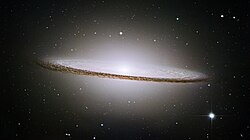Archivo:Sombrero Galaxy in infrared light (Hubble Space Telescope and Spitzer Space Telescope).jpg

Este archivo es de Wikimedia Commons y puede ser usado por otros proyectos. La descripción en su página de descripción del archivo está mostrada debajo.
Resumen
| DescripciónSombrero Galaxy in infrared light (Hubble Space Telescope and Spitzer Space Telescope).jpg |
English: NASA/ESA Hubble Space Telescope and NASA's Spitzer Space Telescope joined forces to create this striking composite image of one of the most popular sights in the universe. Messier 104 is commonly known as the Sombrero galaxy because in visible light, it resembles the broad-brimmed Mexican hat. However, in Spitzer's striking infrared view, the galaxy looks more like a "bull's eye."
Spitzer's full view shows the disk is warped, which is often the result of a gravitational encounter with another galaxy, and clumpy areas spotted in the far edges of the ring indicate young star-forming regions. The Sombrero galaxy is located some 28 million light-years away. Viewed from Earth, it is just six degrees south of its equatorial plane. Spitzer detected infrared emission not only from the ring, but from the center of the galaxy too, where there is a huge black hole, believed to be a billion times more massive than our Sun. The Spitzer picture is composed of four images taken at 3.6 (blue), 4.5 (green), 5.8 (orange), and 8.0 (red) microns. The contribution from starlight (measured at 3.6 microns) has been subtracted from the 5.8 and 8-micron images to enhance the visibility of the dust features.Français : Le Hubble de la NASA/de l'ASE et le Spitzer de la NASA combinent leurs forces pour créer cette image composite de l'une des plus célèbres vues de l'univers. Messier 104 est communément connu sous le nom Galaxie du Sombrero car dans cette lumière visible, il ressemble aux larges bords d'un chapeau mexicain. Cependant, dans la perception infrarouge du Splitzer, la galaxie ressemble plus à une "cible".
La galaxie du Sombrero est localisée à 28 millions d'années lumières. Vue de la terre, elle est juste à six degrés sud de sa trajectoire équatoriale. Spitzer détecte une émission infrarouge pas seulement depuis le cercle, mais également du centre de la galaxie, dans lequel se trouve un énorme trou noir, un milliard de fois plus gros que notre soleil. L'image du Splitzer est composée de quatre images prises à 3.6 (bleu), 4.5 (vert), 5.8 (orange) et 8.0 (rouge) microns. |
| Fecha |
entre mayo de 2003 y junio de 2003 date QS:P,+2003-00-00T00:00:00Z/9,P1319,+2003-05-00T00:00:00Z/10,P1326,+2003-06-00T00:00:00Z/10 |
| Fuente | |
| Autor | NASA/JPL-Caltech and The Hubble Heritage Team (STScI/AURA) |
| Otras versiones |
 |
|
Deutsch: Dieses Bild wurde als Bild der Woche auf der tschechischen Wikipedia für die 36 Woche ausgewählt, 2017. English: This image was selected as a picture of the week on the Czech Wikipedia for 36th week, 2017. Français : Cette image est sélectionnée en tant qu’image de la semaine sur la Wikipédia Tchèque pour la 36e semaine de 2017. Italiano: Questa immagine è stata selezionata come Immagine della settimana su Wikipedia in ceco per la XXXVI settimana del 2017. Македонски: Сликава е избрана за слика на неделата на чешката Википедија за XXXVI недела од 2017 година. Русский: Эта иллюстрация была выбрана изображением недели в чешском разделе «Википедии» для недели номер 36 2017 года. Українська: Ця ілюстрація була вибрана зображенням тижня в чеському розділі «Вікіпедії» для тижня номер 36, 2017 року. |
Licencia
| Public domainPublic domainfalsefalse |
| This file is in the public domain because it was created by NASA and ESA. NASA Hubble material (and ESA Hubble material prior to 2009) is copyright-free and may be freely used as in the public domain without fee, on the condition that only NASA, STScI, and/or ESA is credited as the source of the material. This license does not apply if ESA material created after 2008 or source material from other organizations is in use. The material was created for NASA by Space Telescope Science Institute under Contract NAS5-26555, or for ESA by the Hubble European Space Agency Information Centre. Copyright statement at hubblesite.org or 2008 copyright statement at spacetelescope.org. For material created by the European Space Agency on the spacetelescope.org site since 2009, use the {{ESA-Hubble}} tag. |
Leyendas
Elementos representados en este archivo
representa a
image/jpeg
Historial del archivo
Haz clic sobre una fecha/hora para ver el archivo a esa fecha.
| Fecha y hora | Miniatura | Dimensiones | Usuario | Comentario | |
|---|---|---|---|---|---|
| act | 22:46 20 jul 2009 |  | 3 000 × 1 681 (3,98 MB) | Tryphon | {{Information |Description=NASA/ESA Hubble Space Telescope and NASA's Spitzer Space Telescope joined forces to create this striking composite image of one of the most popular sights in the universe. Messier 104 is commonly known as the Sombrero galaxy bec |
Usos del archivo
La siguiente página enlaza a este archivo:
Metadatos
| Título de la imagen |
|
|---|---|
| Orientación | Normal |
| Resolución horizontal | 300 dpi |
| Resolución vertical | 300 dpi |
| Software usado | Adobe Photoshop 7.0 |
| Fecha y hora de modificación del archivo | 10:26 3 may 2005 |
| Espacio de color | Sin calibrar |
| Altura de la imagen | 3 000 px |
| Ancho de la imagen | 1 681 px |
| Fecha y hora de la digitalización | 07:28 28 abr 2005 |
| Fecha en la cual fueron modificados por última vez los metadatos | 07:28 28 abr 2005 |
| Versión IIM | 2 |

